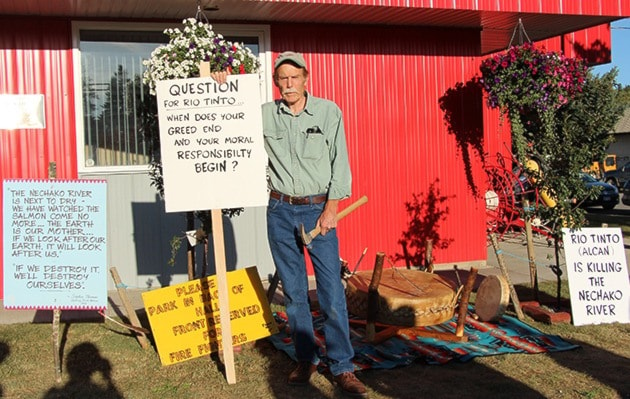One cried, another left abruptly. Thirty years did not dampen the emotions — anger, despair, or hope, to name a few — that some felt in the effort to make change regarding the management of the Kenney Dam-controlled Nechako River.
Over 50 people, young and seasoned, filled Vanderhoof’s fire hall to contribute their values of the Nechako River on Aug. 16.
Hosted by the District of Vanderhoof to kickstart the process of creating a river management plan, the meeting itself was under attack as some questioned the usefulness of gathering community values.
“There’s a long story about people who care about the river,” said Henry Klassen, chair of the Nechako Watershed Council. “I think we’re on the wrong track here, wasting our time.”
Citizens groups in the region have been voicing concerns on river health since the late 1970s, when dam manager Alcan — took over by Rio Tinto in 2007 — announced new smelters that threatened river flows as well as the regional human and wildlife that they support.
Some attendees referred to similar data that are collected from the community, decades ago or recently, and are now archived in UNBC, while others expressed insult in being asked the question.
“Obviously [fish and wildlife, agriculture, flooding concerns, and recreation] involving the river are our values,” he said. “I feel silly putting trivial things [i.e. water too low for fishing.]
“The essence is the community involvement in the last 30 years.”
Accompanied by drumming, Mel Lebatch from Saik’uz First Nation sang a Carrier song called “Four Winds” at the meeting and urged for meaningful consultation.
“Already, my daughter asked why the water is so slow,” Lebatch said. “There are people who fish but can’t, struggling in their lifestyle.”
“I want our way of life to still be here for our kids and grandkids.”
She added that the consultation and change needs to be done cautiously, commenting on the lack of attendance from other Saik’uz First Nation members.
“We need to be involved and if we are slow to be involved, that’s the way it needs to be,” she said. “It needs to be meaningful.
“It’s up to us if our elders are not there.”
Meeting revives passion and energy
Chief Larry Nooski of Nadleh Whut’en First Nation and Cheslatta Carrier Nation’s chief policy advisor Mike Robertson also attended the meeting.
“It’s important to keep this passion alive and build on it,” Robertson said. “Cheslatta just donated their Kemano archives to the university.
“Education is key.”
He added that Cheslatta is also looking into a reservoir management plan.
“It’s crucial to look above the dam to see where the water comes from,” he said.
For Nooski, the meeting is a good start as municipal governments, but First Nation communities need to maintain their autonomy in the discussion.
“I wouldn’t give up in this process,” he said. “We have got to continue developing these tools so we can have a say in what goes on at the land.”
One of his reasons for attendance is to share with the public the Yinka Dene ‘Uza’hné surface water management policy, enacted by the Nadleh Whut’en and Stellat’en First Nations in March for their territories’ waters.
“We have more at stake here to lose,” he said. “We do have laws.”
Having met B.C.’s premier Christy Clark last fall and the water comptroller in May on a potential management plan for the Nechako River, Vanderhoof’s mayor Gerry Thiessen stated that the meeting is merely a starting point of a process.
“The values of the river need to be reconfirmed on a regular basis,” Thiessen said. “[Creating a plan] would require consultation at a much greater scale.”
From the river manager
Earlier this month, the district met with the provincial government and Rio Tinto regarding a potential plan for Nechako River. In a previous meeting with the district, the Ministry of Forests, Lands and Natural Resource Operations stated that WUPs are usually initiated by industry.
“Rio Tinto is prepared to contribute to an Integrated Watershed Plan through development of a Water Management Plan which includes engagement with communities, stakeholders, municipal and provincial elected officials,” responded the British-Australian mining and metals company in an email. “We recognize that river health must include consideration for land use as well as water management.
“All agriculture, forestry and fisheries issues need to be considered in an Integrated Watershed Plan.”
The recent rebuild of its aluminum smelter in Kitimat highlighted the company’s intention to operate for many decades in B.C., states Kevin Dobbin of Rio Tinto’s B.C. operations.
“Rio Tinto actively participates in research and monitoring initiatives to ensure fish and wildlife populations are protected for the long term,” Dobbin stated. “We are following very specific flow management criteria that were developed by governments in response to public concerns about fisheries, flooding and wildlife concerns.”
According to the Ministry of Environment, B.C.‘s provincial government has been developing Water Use Plans for water control structures in the last decade to address a growing concern in fish resources and their relationship with flood protection and other water uses.
Twenty-three of B.C. Hydro’s facilities currently have implemented Water Use Plans — with one in the works for the Cleveland and Seymour dams — in consultation with water licensees, government agencies, First Nations, and the general public to address interests at stake.
